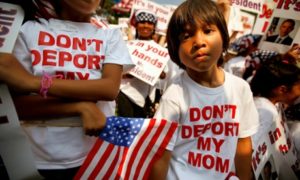
But as a story in The Guardian details, the community has fallen far short of the political power that one would expect to stem from being the state’s largest demographic group.
With a state population of 39 percent, just past the white population of 38.8 percent, Latinos far outnumber Asian Americans (14.9 percent) and African Americans (7.2 percent) in California. Analysts expect that these numbers will pay off for Latinos at some point, but it hasn’t happened yet. And that’s largely because of who votes.
Though the Latino community was called “an awakened giant” by the Pew Research Center, the 5.9 million eligible Hispanic voters in California in 2012 represented just 42 percent of California’s total population of Hispanics—compared to 80 percent of California whites who are eligible to vote.
Nationally, of the 53 million Latinos in the U.S., 7 million are undocumented immigrants, 5 million are legal immigrants who are not citizens and cannot vote, and 17 million are too young to vote—leaving an electorate of just 24 million, of which less than half votes, compared to around two-thirds of whites and African-Americans.
Analysts say such numbers explain why the needs of Latinos are not being met. As a prime example, they point to the two million deportations occurring under President Obama, a number far higher than the Bush administration. This despite the fact that they voted for him overwhelmingly in the last two elections, handing him as many as 8 states and 80 electoral college votes in 2008 and in 2012 going for him over Mitt Romney at a rate of 71 percent to 27 percent, which kept swing states like Colorado and Nevada blue.
Reacting to the label of “the deporter-in-chief” that Latino activists have slapped on him, Obama last week met with Latino lawmakers and ordered immigration officials to review deportation practices to see if they could be “more humanely” enforced “within the confines of the law.”
“Latinos are punching below their weight,” said Mark Hugo Lopez, director of the Pew Research Center’s Hispanic Trends Project, noting to the Guardian that there are very few districts where Latino votes could make a difference in November’s congressional elections.
Roberto Suro, a Latino affairs scholar at the University of Southern California, said where you vote also matters. While there were 53 million Latinos in the U.S. – 17.2 percent of the population—on election day in 2012, they accounted for just 10.8 percent of eligible voters and 8.4 percent of actual voters. In addition, Suro noted, half lived in Texas and California, which don’t swing in presidential races.
As for California, the growth of Latinos presents challenges for the state, as a study by Washington-based Excelencia in Education found that only 16 percent of California Latinos hold a college degree, which lags well behind the 39 percent figure of the state as a whole. And the numbers of Latinos attaining college degrees is declining, not improving.
In the state of California, Latinos make up more than half of the state’s grade school students.
“It’s increasingly urgent for this state to get serious about Hispanic kids because they are the ones doing the least well in school,” Patricia Gandara, UCLA professor and author of “The Latino Education Crisis: The Consequences of Failed Social Policies,” told New American Media, noting that one-quarter of California Latino high school students drop out.
Despite the gloom, there have been significant political victories for Latinos: Between 1996 and 2011 the number of Latinos serving in elected office rose from 3,743 to 5,850—including 24 members of the House of Representatives and two U.S. senators, New Jersey’s Bob Menendez, a Democrat, and Florida’s Marco Rubio, a potential Republican presidential candidate.
And as the Latino electorate swells from 23 million to 40 million by 2030, the number of elected and appointed officials will undoubtedly rise in concert.
“I would say the glass is half full,” said Hugo Lopez, of the Pew Research Center.


